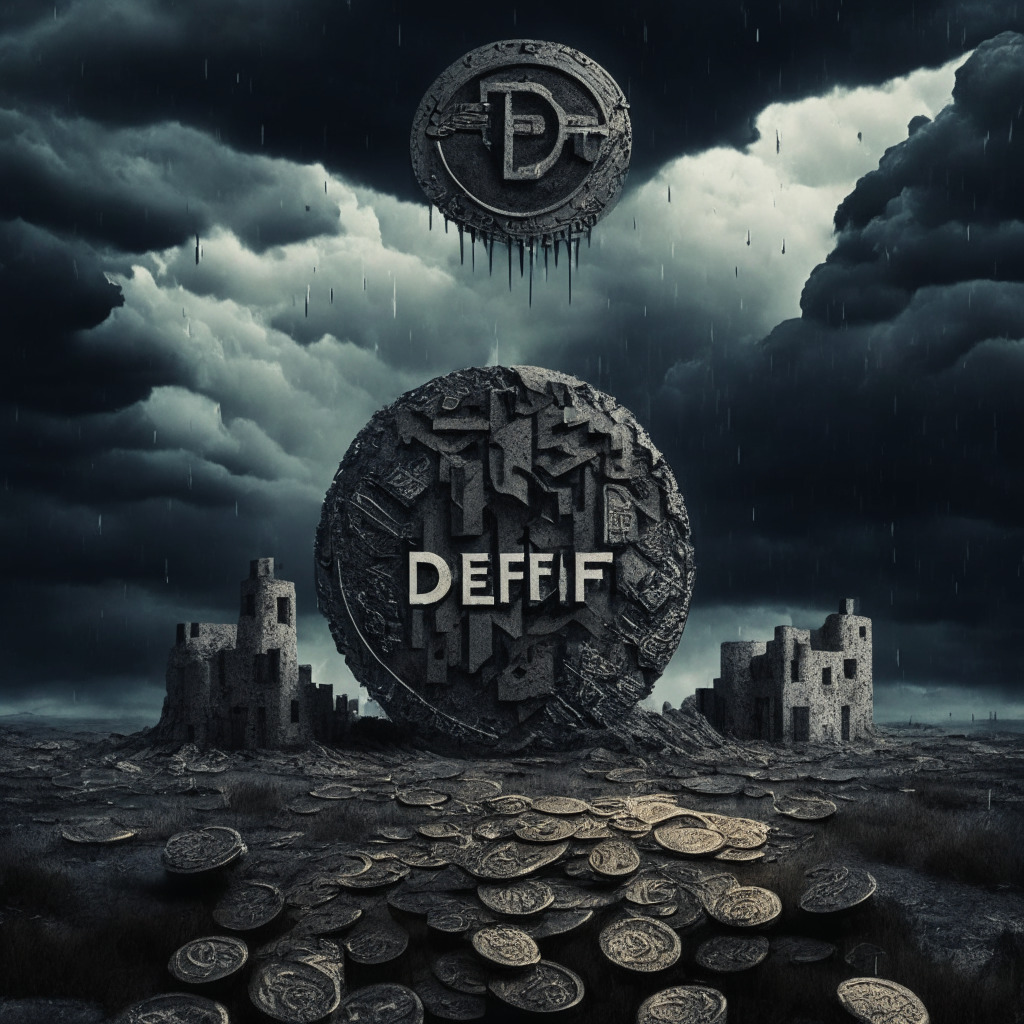“The decentralized finance platform, Balancer, suffered a security breach due to a ‘social engineering attack’ on its DNS service provider. The attack resulted in a loss of $238,000 in cryptocurrency. It’s speculated that ‘Angel Drainer phishing contracts’ were in play, causing significant concerns about DNS security patterns and considerations for switching to more secure DNS registrars.”
Search Results for: Balancer
Balancer’s Vulnerability Exploit: A $900k Loss and Lessons to Learn in DeFi Space
The decentralized finance protocol Balancer experienced a significant exploit, leading to a loss of nearly $900,000. This unexpected event comes after recent concerns about a critical vulnerability affecting numerous V2 pools. Remote asset networks like Ethereum, Polygon, Arbitrum among others were reportedly exposed to this vulnerability, reminding of the constant security challenges DeFi platforms face.
Ethereum’s Balancer Protocol Security Concern: The Persistent Challenge of Blockchain Safety
“The blockchain space faces security concerns following a vulnerability warning by Ethereum and DeFi protocol, Balancer. Balancer disclosed $2.8 million hangs in balance, urging users to withdraw their assets. Despite the risk, the incident underscores the importance of maintaining solid security within the blockchain technology.”
Balancer’s Security Flaw: A Perilous Slip or a Bold Demonstration of Crisis Response?
Balancer, Ethereum’s project, recently detected a severe security flaw posing a risk to millions of crypto assets. While emergency response halted numerous pools, roughly 1.4% of the total locked value, approximately $10 million, remains vulnerable. BAL token holders are in strategic withdrawal, and the severity of the vulnerability has not been fully disclosed.
Crypto Website Breach: Steering Through Chaos, Learning From Ordswap’s Experience
“Ordswap, a Bitcoin Ordinals marketplace, temporarily lost control of its domain, redirecting users to phishing links. The issue wasn’t Ordswap’s fault, but attributed to their hosting firm, Netlify. During this, Ordswap took quick steps to help users recover their private keys and secure their assets.”
Navigating Web3’s Growing Pains: Analyzing Security Challenges Amid Crypto Innovations
“The Galxe protocol recently suffered a DNS attack, causing significant losses and posing questions about the feasibility of security in Web3 platforms. The incident highlights growing security challenges, with Web3-related security faults causing an astounding $686 million loss in the third quarter this year. The future of the blockchain space depends on balancing innovation and risk.”
Biggest Heist in Crypto History: Mixin Network Suffers Unprecedented $200M Security Breach
Mixin Network suffered a security breach resulting in a loss of nearly $200 million from the mainnet. In an effort to investigate the incident and protect user assets, Mixin has temporarily paused deposit and withdrawal services, but asset transfers on its platform continue. The team is now devising a recovery strategy.
DeFi Dip or Adjustment: Analyzing Recent Drop in Decentralized Finance Activity
“The DeFi sector experienced a 15.5% drop in August, leading to speculations of losing steam. Despite this, investor interest remains strong with blockchain infrastructure and DeFi investments totalling $580 million. The growth of DApp ecosystems offers optimism, but recent security breaches cause concern.”
Security Chaos in Crypto: Unpacking the $41M Stake Heist and Crypto’s Million Dollar Losses
The article discusses the aftermath of a $41M cryptocurrency heist, with the responsible anonymous hackers gradually transferring stolen funds to different digital wallets. Through multiple related incidents, the piece raises alarms about substantial security concerns within the crypto industry and highlights the potential of AI in identifying threats.
Exploring the Rising Star of Cryptocurrencies – Chainlink vs. Launchpad.xyz: Potential Gains and Risks
Chainlink’s (LINK) price has increased due to its partnership with Swift’s Cross-Chain Interoperability Programme in tokenization trials. This partnership, along with other positive drivers, like integration with Balancer, predicts a robust upward trajectory for LINK in the cryptocurrency market.
The DeFi Dilemma: Balancing Game-Changing Innovations with Rigorous Security
“Decentralized finance (DeFi) protocols are reshaping sectors but facing security complexities as shown by the Balancer protocol losing $900K due to a flagged vulnerability. Despite challenges, DeFi’s consistent innovation and adaptability demonstrate resilience. Yet, escalating security incidents suggest a need for more rigorous measures.”
Web 3 Dilemma: $1.2 Billion Lost to Hacks and Fraud Amid the Blockchain Revolution
“The digital ecosystem of Web 3 platforms has reported a loss of over $1.2 billion this year due to hacks and rug pulls, states web3 bug bounty establishment, Immunefi. With heavy losses in August 2021, Ethereum witnessed the most manifold of attacks. Hacks clearly outweighed frauds as the root cause of these financial missteps. These financial drains highlight the need for thorough scrutiny of blockchain technology’s defense mechanisms.”
1inch Joins Coinbase’s Ethereum Layer 2: The Progress, Promise and Pitfalls of Base Network
Decentralized exchange aggregator 1inch has partnered with Coinbase’s Ethereum Layer 2 network Base, aiming to leverage liquidity from 15 functioning decentralized exchanges. The agreement introduces 1inch’s limit order protocol, contrasting from standard instant price conversions, and integrating Base within robust Layer 2 networks like Optimism, Arbitrum, and zkSync Era. Despite impressive growth and transaction rates, Base faces challenges with a high proportion of meme coin activity, suggesting potential volatility.
Decentralized Finance: A Revolutionary Potential Sailing Rough Waters
“The capital held in decentralized finance (DeFi) protocols has dipped to $37.5 billion, its lowest since February 2021. This drop comes amidst concerns about governmental regulations, falling crypto prices, and recent scandals. Despite Ethereum’s rise, DeFi’s total value locked (TVL) has contracted, suggesting inherent challenges exist in the DeFi market.”
Unmasking the Zunami Protocol Price Manipulation: Over $2.1 Million Lost in Cyber-Offensive
The Decentralized Finance (DeFi) platform Zunami Protocol has suffered a price manipulation attack involving its stablecoin pools on Curve Finance, leading to potential losses of over $2.1 million. The exploit participants reportedly used a flash loan to significantly alter the price, resulting in stolen funds. The event underscores the necessity of stringent security measures for DeFi ecosystems.
Unraveling DeFi Instability: Curve Founder’s Actions as Catalyst for Market Risks
Michael Egorov, founder of Curve Finance, destabilized on-chain lending markets by leveraging his CRV holdings for large token loans, potentially triggering a wide-scale liquidation and distressing debts within the DeFi ecosystem. The situation underscores the importance of robust response strategies in the decentralized finance world.
Navigating the Bitcoin Mining Labyrinth: Texas’ Struggle between Economy and Ecology
“Texas, a significant bitcoin mining hub, is experimenting with integrating mining into power grids. However, this move has been criticized for potentially prioritizing an environmentally harmful industry over local communities. On the other hand, supporters highlight the potential grid benefits and job opportunities, but concerns about sustainability and water usage persist.”
Navigating Blockchain Security: Unpacking the Conic Finance Exploit and the Path Forward
The decentralized finance platform, Conic Finance, was recently exploited for $3.26 million in ETH via a single transaction. This incident highlights ongoing concerns about blockchain security and emphasizes the need for more sophisticated protection measures even as blockchain contracts continue to innovate and evolve.
BlackRock’s Bitcoin ETF and the Shifting Crypto Landscape: Winners, Losers, and Unfazed Entities
“BlackRock’s application for a Bitcoin ETF heralds the rise of institutional investment in crypto. Decentralized finance (DeFi) remains steady, while zkSync, zkEVM, and Starknet zero-knowledge (ZK) protocols race for dominance. The security tokens market, proliferated with tokenized securities, remains controversial while growing steadily.”
Ethereum Bot Takes $200M Flash Loan for a Mere $3.24 Profit: Clever Strategy or Unnecessary Risk?
An arbitrage bot made complex moves using Ethereum blockchain, taking a $200 million flash loan while only profiting $3.24. The transaction involved borrowing DAI from MakerDAO, trading Wrapped Ether, and purchasing Threshold Network tokens, showcasing the pursuit of profit in crypto trading.
Flash Loans: Efficient Capital Raiser or Risky Exploits Waiting to Happen?
An arbitrage bot recently flash loaned $200 million in DAI stablecoin from MakerDAO, gaining a small $3.24 profit after fees. This highlights the ongoing debate in the crypto community regarding flash loans’ efficiency versus their potential security risks and misuse.
DeFi Exploit Costs Sturdy Finance 442 ETH: Analyzing Security and Future Safeguards
Sturdy Finance, a DeFi lending protocol, recently suffered an exploit resulting in a loss of 442 ETH (around $768,800). The platform has paused activity for investigation. The attacker allegedly manipulated the price oracle of a collateral pool, draining funds from Sturdy using a re-entrancy attack.
USDC Integration into Arbitrum: Exciting Possibilities and Potential Challenges
The integration of Circle Internet Financial’s stablecoin USDC into Arbitrum, a leading layer 2 scaling solution for Ethereum, offers intriguing possibilities for businesses and the crypto community. However, potential challenges posed by software bugs and token price fluctuations should be considered before embracing this rapidly-evolving blockchain innovation.
DeFi Protocols Unite for Daring Crypto Rescue: Collaboration or Centralization?
Several DeFi protocols, including Balancer, TempleDAO, Euler Finance, and Inverse Finance, are collaborating on a rescue mission to recover $300,000 worth of frozen cryptocurrency from a 2023 hack. The plan involves a “permissioned arbitrage” and showcases the DeFi industry’s resilience and potential for joint efforts in tackling challenges.
Hacker Targets Abandoned Meme Tokens: A Victimless Crime or Crypto Ecosystem Cleanup?
An opportunistic hacker has been targeting abandoned meme tokens, draining their liquidity using flash loans from DeFi protocol Balancer. The method, spotted by Giorgi Khazarade, involves borrowing large sums of money and redirecting it to increase token pool volume, then draining remaining liquidity. This highlights potential vulnerabilities in abandoned meme tokens and the need for robust security measures to protect investors from potential losses.
























